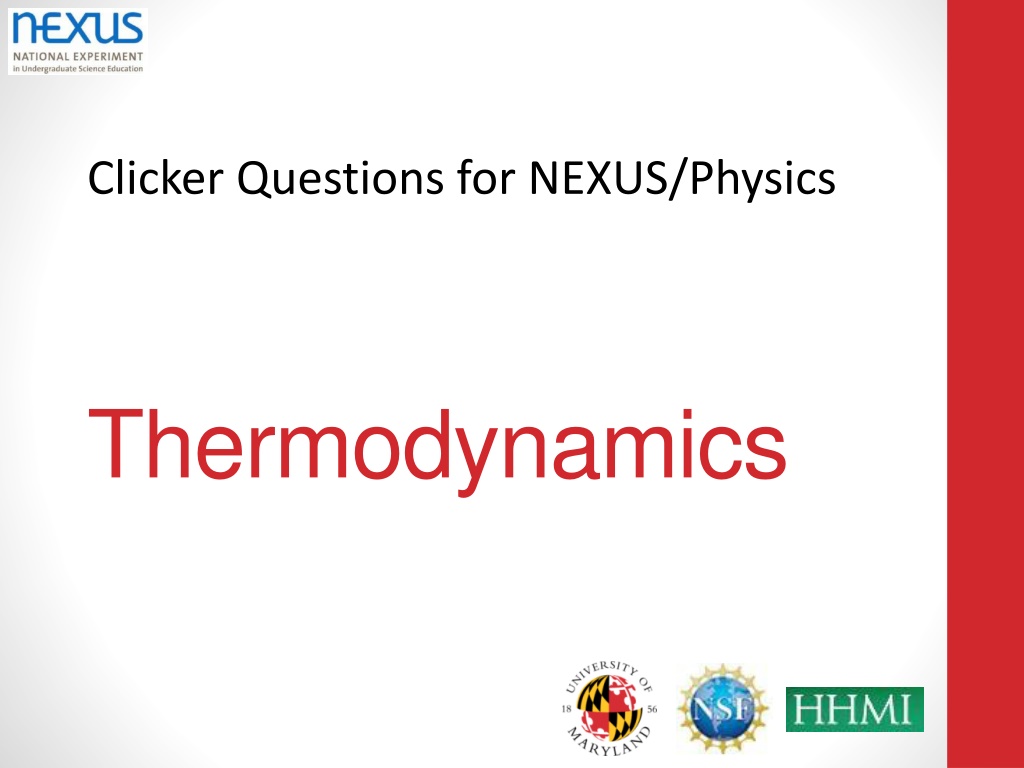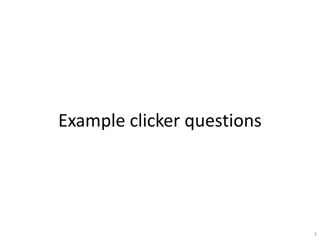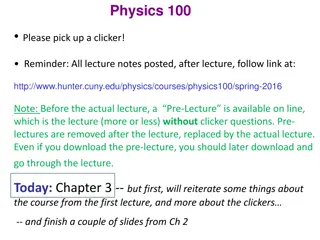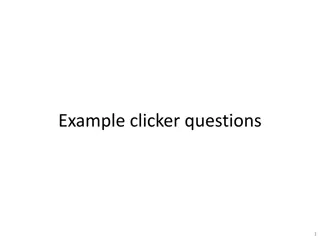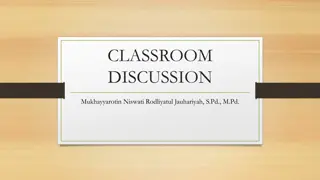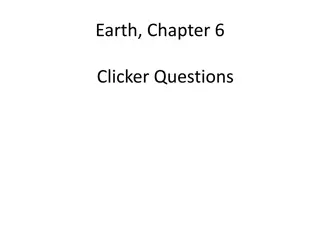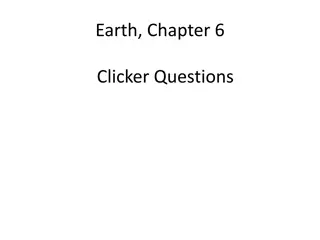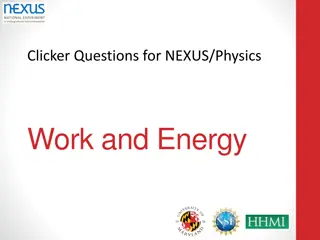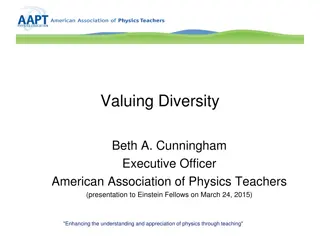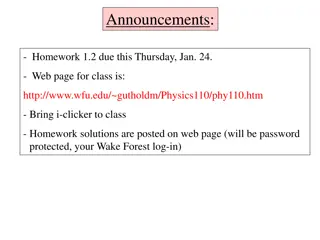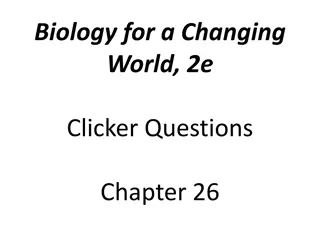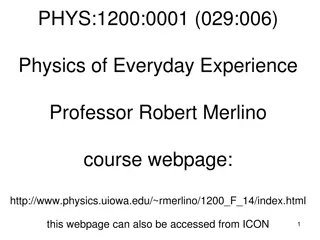Enhancing Classroom Discussions with Clicker Questions in Physics
Encourage class discussions in physics using clicker questions as stimuli to probe students' thinking. Utilize mistakes for deeper understanding rather than focusing on right answers. Facilitate student-student interactions post-question responses to enhance learning. Address idealizations and modeling issues to promote critical thinking. Consider cluster questions for group engagement and problem-solving activities.
Download Presentation

Please find below an Image/Link to download the presentation.
The content on the website is provided AS IS for your information and personal use only. It may not be sold, licensed, or shared on other websites without obtaining consent from the author. Download presentation by click this link. If you encounter any issues during the download, it is possible that the publisher has removed the file from their server.
E N D
Presentation Transcript
Clicker Questions for NEXUS/Physics Thermodynamics
A note on usage: The clicker slides in this booklet are meant to be used as stimuli to encourage class discussion. They are intended for use in a class that attempts to help students develop a coherent and sophisticated understanding of scientific thinking. They are NOT intended as items to test whether students are right or wrong or know the correct answer by one-step recall if enough cues are given. This has a number of instructional implications that are reviewed in general on the next four slides. The individual slides also contain annotations discussing their intended use.
Usage: 1 Feedback One of the most important values of a clicker- response system is to provide instructors with some understanding of what students are thinking. Good clicker questions can be highly revealing (and surprising). But the critical fact is not that the students make mistakes but to use those mistakes to probe their thinking and find out why. This raises the importance of a rich subsequent discussion well above letting the students know what the right answer is.
Usage 2: Student-student interactions The critical value for student learning occurs in what happens after a clicker question has obtained a mixed response from the students. The standard next cue is, Find someone who disagreed with the answer you chose and see if you can convince them. After a minute or two of discussion, a second click may show students having moved dramatically towards the correct answer. A brief call for who changed their answer and why can lead to a useful exchange. When they have not moved significantly, more discussion is called for.
Usage: 3 Incompletely specified questions Some items have questions that are simple if idealized assumptions are made, subtler if they are not. Part of the discussion of these items are intended to include issues of modeling, idealizations, and hidden assumptions. Questions where answers are not provided. In these items, the intent is to have students come up with potential answers and have the instructor collect them and write them on the board. Occasionally, especially at the beginning of a class, it may take some time before students are willing to contribute answers. It can help if you have some prepared answers ready, walk around the class, and put up the answers as if they came from the students. This can help students get more comfortable with contributing.
Usage: 4 Cluster questions Some questions are meant to be used as part of a group of questions. In this case, resolving the answers to individual questions is better left until the entire group is completed. The value of the questions are often in the comparison of the different items and in having students think about what changes lead to what differences and why. Problem solving items In these items (indicated by a pencil cluster logo), the intent is to have students work together to solve some small problem. After a few minutes, ask the groups to share their answers, vote on the different answers obtained, and have a discussion.
Critical Experiment 1 If we have equal amounts of the same kinds of materials at different temperatures and put them together, what happens? 200 g of water at 80 C 200 g of water at 20 C A. B. C. D. E. pretty close to 50 C pretty close to 80 C pretty close to 20 C greater than 80 C less than 20 C
Critical Experiment 2 If we have unequal amounts of the same kinds of materials at different temperatures and put them together, what happens? 100 g of water at 80 C 200 g of water at 20 C A. B. C. D. E. pretty close to 40 C pretty close to 80 C pretty close to 20 C greater than 60 C something else
Critical Experiment 3 If we have equal masses of different kinds of materials at different temperatures and put them together, what happens? 200 g of copper at 80 C 200 g of water at 20 C A. B. C. D. E. pretty close to 50 C pretty close to 80 C pretty close to 20 C greater than 80 C less than 20 C
If you touch the cloth part of your chair and the metal part, which feels warmer? A. The metal part. B. The cloth part. C. They all feel the same
If you touch the cloth part of your chair and the metal part, which is at a higher temperature? A. The metal part. B. The cloth part. C. They are both the same
The objects listed in A-C below are placed in an oven heated to 90 C (~160 F) and left for a long time. Which object will feel warmest when you touch it? A. A ball of cotton B. A stick of wood C. A metal bar D. They would all feel the same
The objects listed in A-C below are placed in an oven heated to 90 C (~160 F) and left for a long time. Which object will have the highest temperature? A. A ball of cotton B. A stick of wood C. A metal bar D. They would be the same temperature
When baking a potato (white or sweet) in the oven, I find they come out much more uniformly cooked if I stick aluminum rods into the potato. (You can buy such rods in any kitchen supply store.)Why do you think this works? A. Because the aluminum has a much higher specific heat than the potato and so it holds a lot of thermal energy. B. Because the aluminum has a much lower specific heat than the potato and so it lets the potato have most of the thermal energy. C. Because the aluminum has a much higher thermal conductivity than the potato so putting the rods in brings the thermal energy into the center of the potato more quickly so it cooks more uniformly. D. Some other reason.
When I bake a sweet potato in the oven, I always put it on a thin sheet of aluminum foil. This is because sometimes the potato exudes a sugary juice that burns and makes a hard-to-clean-up mess if it drips on the bottom of the oven. When I m ready to take the potato out of the hot (400o F) oven after an hour of cooking, I find I can pick up the aluminum foil with my bare hands without getting burned. Why do you think this is so? A. Because the aluminum foil has a high specific heat so that it holds on to most of the thermal energy. B. Because the aluminum foil has a low specific heat and not much mass, so even at a high temperature it doesn t have a lot of thermal energy in it to burn me. C. Because the aluminum foil has a low thermal conductivity so that although the foil is hot, the heat doesn t flow into my hand. D. Because the aluminum foil doesn t get hot in the oven, even though the oven is at a high temperature. E. Some other reason.
A block sitting on a smooth table was given a push. It slides across the table and comes to a stop. After the push is complete but before the block has stopped, which of the following statements are (pretty close to being) true? A. The mechanical energy of the block is conserved. B. The mechanical plus thermal energy of the block is conserved. C. The mechanical energy of the block plus table is conserved. D. The mechanical plus thermal energy of the block plus table is conserved. E. Mechanical + thermal energy is not conserved in this process.
Suppose an isolated box of volume 2V is divided into two equal compartments. An ideal gas occupies half of the container and the other half is empty. When the partition separating the two halves of the box is removed and the system reaches equilibrium again, how does the new internal energy of the gas compare to the internal energy of the original system? A. The internal energy increases B. The internal energy decreases C. The internal energy stays the same D. There is not enough information to determine the answer
What are the signs of the following first law quantities for: an egg placed in boiling water Uinternal Q (heat absorbed BY the system) 1 > 0 2 < 0 3 0 4 > 0 5 < 0 6 0 7 > 0 8 < 0 9 0 W (work done BY the system) < 0 0 0 > 0 > 0 > 0 > 0 0 > 0 > 0 < 0 > 0 < 0 < 0 < 0 0 0 0
What are the signs of the following first law quantities for: a person standing still holding an object at arm s length Uinternal Q (heat absorbed BY the system) 1 > 0 2 < 0 3 0 4 > 0 5 < 0 6 0 7 > 0 8 < 0 9 0 W (work done BY the system) < 0 0 0 > 0 > 0 > 0 > 0 0 > 0 > 0 < 0 > 0 < 0 < 0 < 0 0 0 0
What are the signs of the following first law quantities for: a flashlight left on Uinternal Q (heat absorbed BY the system) 0 W (work done BY the system) < 0 1 2 3 4 5 6 7 8 9 > 0 < 0 0 > 0 0 > 0 > 0 > 0 > 0 0 < 0 > 0 > 0 0 < 0 > 0 > 0 < 0 < 0 < 0 < 0 0 0 0 0
A gas is held behind a partition in an insulated chamber, the other side of the partition is vacuum. The partition breaks involving negligible energy change. What happenedafter equilibrium is reached? Uinternal Q (heat absorbed BY the system) 1 > 0 2 < 0 3 0 4 > 0 5 < 0 6 0 7 > 0 8 < 0 9 0 W (work done BY the system) < 0 0 0 > 0 > 0 > 0 > 0 0 > 0 > 0 < 0 > 0 < 0 < 0 < 0 0 0 0
During soccer practice one of your teammates sprains her ankle. You take an instant cold pack from the first aid box to use on her ankle. It is not at all cold when you take it out. The instructions on the cold pack tell you to punch the pack so that you break open a sack of chemicals inside it. When you do that you notice that the cold pack rapidly becomes quite cold. What happened? A. By punching the pack you gave the chemicals inside the energy they needed to permit the cooling down. B. A chemical reaction produced cold as one of its products, which cooled down the cold pack. C. The cold pack forcefully expelled heat into its surroundings, which lowered its temperature. D. Thermal energy was used up in forming chemical bonds, which made the cold pack colder. E. More than one of these F. None of these
After a long time passes, the cold pack returns to room temperature. Why? A. The chemical reaction that made it colder runs in the reverse direction, making it warmer. B. Heat is transferred from your teammate s ankle to the cold pack, making her ankle colder and the cold pack warmer. C. Cold is transferred from the cold pack to your teammate s ankle, making her ankle colder and the cold pack warmer. D. Chemical bonds are formed, releasing energy and heating up the cold pack. E. More than one of these F. None of these
After the cold pack returns to room temperature, what can you say about the total energy (chemical, thermal, and anything else) stored in the cold pack? A. It is greater than when you first took the cold pack out of the first-aid kit. B. It is less than when you first took the cold pack out of the first-aid kit. C. It is equal to when you first took the cold pack out of the first-aid kit. D. Not enough information to tell.
